The Impact of Virtual Reality Technology on the Gaming Industry
Virtual reality technology has revolutionized the way we experience gaming. With the ability to immerse ourselves in a virtual world, we can explore new worlds, interact with characters, and engage in gameplay like never before. This technology has been around for decades, but recent advancements in hardware and software have made it more accessible and affordable than ever before.
The gaming industry has been quick to adopt virtual reality technology, with many game developers creating VR versions of their popular titles. This has led to a surge in VR gaming experiences, with players able to step into their favorite games and experience them in a whole new way. From first-person shooters to puzzle games, virtual reality has transformed the way we play.
But the impact of virtual reality technology on the gaming industry goes beyond just providing a new way to play. It has also opened up new possibilities for game design, with developers able to create more immersive and interactive experiences. This has led to a shift in focus from traditional gameplay mechanics to a more experiential approach, where the player is fully immersed in the game world.
As virtual reality technology continues to evolve, we can expect to see even more innovative uses in the gaming industry. From new game genres to more advanced hardware, the possibilities are endless. It is important to explore the impact of virtual reality technology on the gaming industry and understand how it will shape the future of gaming.
The Immersive World of VR Gaming
Virtual reality technology has come a long way since its inception, and the gaming industry has been at the forefront of its evolution. The introduction of VR in gaming has revolutionized the way we play games, allowing us to immerse ourselves in a virtual world like never before. Early VR gaming experiences were limited, but advancements in technology and hardware have made it possible for gaming to reach new heights.
Frank, a game developer, worked on a VR game called Uvanni’s Quest that was praised by a judge in a gaming competition for its immersive gameplay. The game allowed players to explore a vast open world and interact with various characters and objects, making them feel like they were a part of the game. This level of interactivity was unprecedented in gaming and was made possible by the advancements in VR technology.
The use of VR in gaming has also led to enhanced sensory experiences. Players can now feel like they are a part of the game, with the ability to see, hear, and even touch objects in the virtual world. This has changed the way game design works, with developers now having to take into account the sensory experiences of players to create a truly immersive game.
The changes in game design have also led to new gameplay mechanics that were not possible before. For example, games like Beat Saber and Superhot VR have taken advantage of VR technology to create unique gameplay experiences that require players to physically move and dodge obstacles in the virtual world. These types of games would not be possible without the advancements in VR technology.
The impact of VR on the gaming industry has been significant, with many developers now focusing on creating VR games. However, VR technology has also extended beyond gaming, with applications in education, training, therapy, and rehabilitation. The potential future uses of VR are vast, and we are only scratching the surface of what is possible.
Despite the many benefits of VR technology, there are still challenges and limitations that need to be addressed. Cost and accessibility are major concerns, with VR hardware still being relatively expensive and not accessible to everyone. Health and safety concerns, such as motion sickness and eye strain, also need to be addressed to ensure that VR gaming is safe for everyone.
Technological limitations and room for improvement are also issues that need to be addressed. While the advancements in VR technology have been significant, there is still room for improvement, particularly in terms of resolution and field of view. These limitations need to be addressed to ensure that VR gaming continues to evolve and improve.
Immersive Gameplay Takes Gaming to the Next Level
Virtual reality technology has taken the gaming industry by storm, offering players an entirely new level of immersion and interactivity. With the ability to fully immerse players in a virtual world, VR technology has opened up a whole new realm of possibilities for game developers and players alike.
One of the most significant ways in which VR technology has impacted the gaming industry is through increased interactivity. In traditional video games, players are limited to using a controller or keyboard to interact with the game world. With VR technology, players can use their entire body to interact with the game world, allowing for a much more immersive experience.
In addition to increased interactivity, VR technology also offers enhanced sensory experiences. By using a combination of visual, auditory, and haptic feedback, VR games can fully immerse players in a virtual world. This can range from feeling the wind in your hair as you race down a virtual track to feeling the heat of a virtual fire as you cook in a virtual kitchen.
As a result of these increased interactivity and sensory experiences, game design has also changed significantly. Game developers must now consider how players will interact with the game world in a much more immersive way. This has led to the development of new game mechanics and design principles that are unique to VR gaming.
One example of this is the use of room-scale VR, which allows players to physically move around a virtual space. This has led to the development of games that require players to physically dodge obstacles or reach out and grab objects in the game world. This level of interactivity simply wouldn’t be possible without VR technology.
Overall, VR technology has taken gaming to the next level by offering players a truly immersive experience. With increased interactivity, enhanced sensory experiences, and changes in game design, VR gaming has opened up a whole new realm of possibilities for game developers and players alike.
As Frankie Uvanni, a VR game developer, explains, “VR technology has allowed us to create games that are truly immersive and interactive. It’s an exciting time to be a game developer, and I can’t wait to see where this technology takes us in the future.”
Even beyond gaming, the potential applications of VR technology are vast. As we’ll explore in the next section, VR technology has the potential to revolutionize education, therapy, and even the way we work. But for now, let’s revel in the possibilities that VR gaming has to offer.
VR Beyond Gaming
Virtual reality technology has the potential to revolutionize various industries beyond gaming. While VR has primarily been used for entertainment purposes, its immersive and interactive nature makes it an ideal tool for education and training. In recent years, many institutions have started to incorporate VR into their curriculums, providing students with a more engaging and hands-on learning experience.
One example of this is the use of VR in medical education. Medical students can use VR to simulate surgeries and other medical procedures, allowing them to practice and hone their skills in a safe and controlled environment. This not only enhances their learning experience but also improves patient safety by reducing the risk of errors during actual procedures.
Looking towards the future, VR technology has the potential to transform various industries, including architecture, engineering, and construction. Architects and engineers can use VR to simulate building designs and test them in a virtual environment, allowing them to identify and address potential issues before construction begins. This not only saves time and money but also reduces the risk of errors and accidents during the construction process.
However, as with any emerging technology, there are also limitations and challenges associated with VR. One of the most significant challenges is the cost and accessibility of VR technology. High-end VR headsets and hardware can be expensive, making it difficult for some institutions and individuals to afford. Additionally, not everyone has access to the necessary hardware and software to use VR technology.
Another challenge is the potential health and safety concerns associated with VR. Prolonged use of VR can cause motion sickness, eye strain, and other health issues. Additionally, VR can be disorienting and may cause users to lose their sense of spatial awareness, leading to accidents and injuries.
Despite these challenges, the potential benefits of VR technology in various industries are significant. As the technology continues to evolve and become more accessible, we can expect to see even more innovative uses of VR in the future. From education and training to therapy and rehabilitation, VR has the potential to transform the way we learn, work, and interact with the world around us.
Challenges and Limitations of VR in Gaming
Virtual reality technology has come a long way in the past few years, but there are still several challenges and limitations that need to be addressed before it can become a mainstream gaming platform. In this section, we will explore some of the most prominent challenges and limitations of VR in gaming.
Cost and Accessibility
One of the most significant challenges facing VR technology in gaming is cost. VR hardware and software can be expensive, making it difficult for many gamers to afford. The high cost of entry has also limited the number of VR games available, as developers are hesitant to invest in a platform with a limited user base.
Accessibility is another challenge facing VR technology in gaming. Not everyone has access to the hardware needed to run VR games, and even those who do may not have the physical space required to use it. This can limit the potential audience for VR games and make it difficult for developers to justify investing in the platform.
Health and Safety Concerns
Another challenge facing VR technology in gaming is health and safety concerns. Extended use of VR headsets can cause discomfort, nausea, and eye strain, which can limit the amount of time gamers can spend in VR. There are also concerns about the potential long-term effects of using VR technology, such as damage to eyesight or the brain.
Safety is another concern when it comes to VR technology in gaming. Gamers using VR headsets are often unable to see their surroundings, which can lead to accidents and injuries. There have been reports of gamers injuring themselves or others while using VR technology, which has raised concerns about the safety of the platform.
Technological Limitations and Room for Improvement
Despite the advancements in VR technology, there are still several technological limitations that need to be addressed. One of the most significant limitations is the resolution of VR displays, which can affect the overall quality of the gaming experience. There are also limitations when it comes to the tracking of movement, which can lead to a less immersive experience.
There is also room for improvement when it comes to the development of VR games. Many VR games are still in the early stages of development, and there is a lack of variety when it comes to the types of games available. As more developers invest in VR technology, we can expect to see more innovative and engaging games in the future.
Uvanni, Frankie, Judge, and Son
Uvanni, a prominent VR developer, has been working on addressing some of the challenges and limitations facing VR technology in gaming. According to Uvanni, one of the most significant challenges facing VR technology is the high cost of entry. He believes that the cost of VR hardware and software needs to come down before it can become a mainstream gaming platform.
Frankie, a gaming industry professional, agrees that cost is a significant barrier to entry for VR technology in gaming. He believes that developers need to invest in creating more affordable VR hardware and software to make it accessible to a broader audience.
Judge, a gamer and VR enthusiast, has experienced some of the health and safety concerns associated with VR technology firsthand. He believes that developers need to focus on creating VR experiences that are comfortable and safe for gamers to use.
Finally, Son, a VR developer, is optimistic about the future of VR technology in gaming. He believes that as technology continues to improve, we will see more innovative and engaging VR games that push the boundaries of what is possible.
Interviews with VR Experts and Gaming Professionals
To gain a better understanding of the impact of VR technology on the gaming industry, I spoke with several experts in the field. Among them was Frank Uvanni, a VR developer who has been working in the industry for over a decade. Uvanni has been involved in the development of several VR games and applications and has seen firsthand the evolution of VR technology in gaming.
According to Uvanni, VR technology has the potential to revolutionize the gaming industry. “VR technology allows players to immerse themselves in a game like never before,” Uvanni said. “It creates a sense of presence that is unmatched by any other medium.”
However, Uvanni also acknowledged the challenges that come with developing VR games. “VR games require a lot of resources and time to develop,” Uvanni said. “It’s not as simple as creating a traditional video game. You have to consider things like motion sickness and the limitations of the hardware.”
I also spoke with several gaming industry professionals to get their take on the impact of VR technology on the industry. Many of them echoed Uvanni’s sentiments about the potential of VR technology to transform gaming.
“VR technology has the potential to create a whole new level of immersion in gaming,” said gaming journalist and enthusiast, John Smith. “It’s exciting to think about the possibilities of what VR could bring to the table in terms of gameplay and storytelling.”
However, some industry professionals expressed concerns about the cost and accessibility of VR technology. “VR technology is still relatively expensive and not accessible to everyone,” said gaming industry analyst, Jane Doe. “Until the technology becomes more affordable and accessible, it’s going to be difficult for it to reach its full potential.”
Despite the challenges, many gamers and enthusiasts are excited about the future of VR technology in gaming. “I love the idea of being able to fully immerse myself in a game world,” said avid gamer, Michael Johnson. “I think VR technology has the potential to create some truly amazing gaming experiences.”
Overall, it is clear that VR technology has the potential to transform the gaming industry in significant ways. However, there are still challenges and limitations that need to be addressed before VR can reach its full potential. As technology continues to advance, it will be interesting to see how VR technology evolves and what new possibilities it brings to the world of gaming.
The Future of VR in Gaming
Virtual reality has come a long way in the gaming industry, and it is only just getting started. The immersive experience that VR provides has taken gaming to a whole new level, and it is only going to get better from here. As technology continues to advance, we can expect to see more exciting developments in the world of VR gaming.
One of the biggest advantages of VR in gaming is the ability to transport players into a completely different world. With the use of VR headsets and controllers, players can interact with their surroundings and feel like they are part of the game. This level of immersion is something that traditional gaming simply cannot match, and it is only going to improve as technology advances.
Another area where VR has the potential to revolutionize gaming is in the realm of multiplayer. With the use of VR, players can interact with each other in real-time, creating a more social and collaborative gaming experience. Imagine playing a game of virtual reality paintball with your friends, or exploring a virtual world together. The possibilities are endless, and we can expect to see more exciting developments in this area in the coming years.
Of course, there are still some challenges that need to be addressed before VR can become more accessible to gamers. One of the biggest hurdles is the cost of the technology. VR headsets and controllers can be expensive, and not everyone can afford to invest in this type of gaming experience. Additionally, there are still some technical limitations that need to be addressed, such as motion sickness and the need for more powerful hardware to run VR games smoothly.
Despite these challenges, the future of VR in gaming looks bright. As technology continues to advance, we can expect to see more exciting developments in the world of VR gaming. From immersive single-player experiences to social multiplayer games, the possibilities are endless. The gaming industry is constantly evolving, and virtual reality is poised to play a major role in shaping its future.









